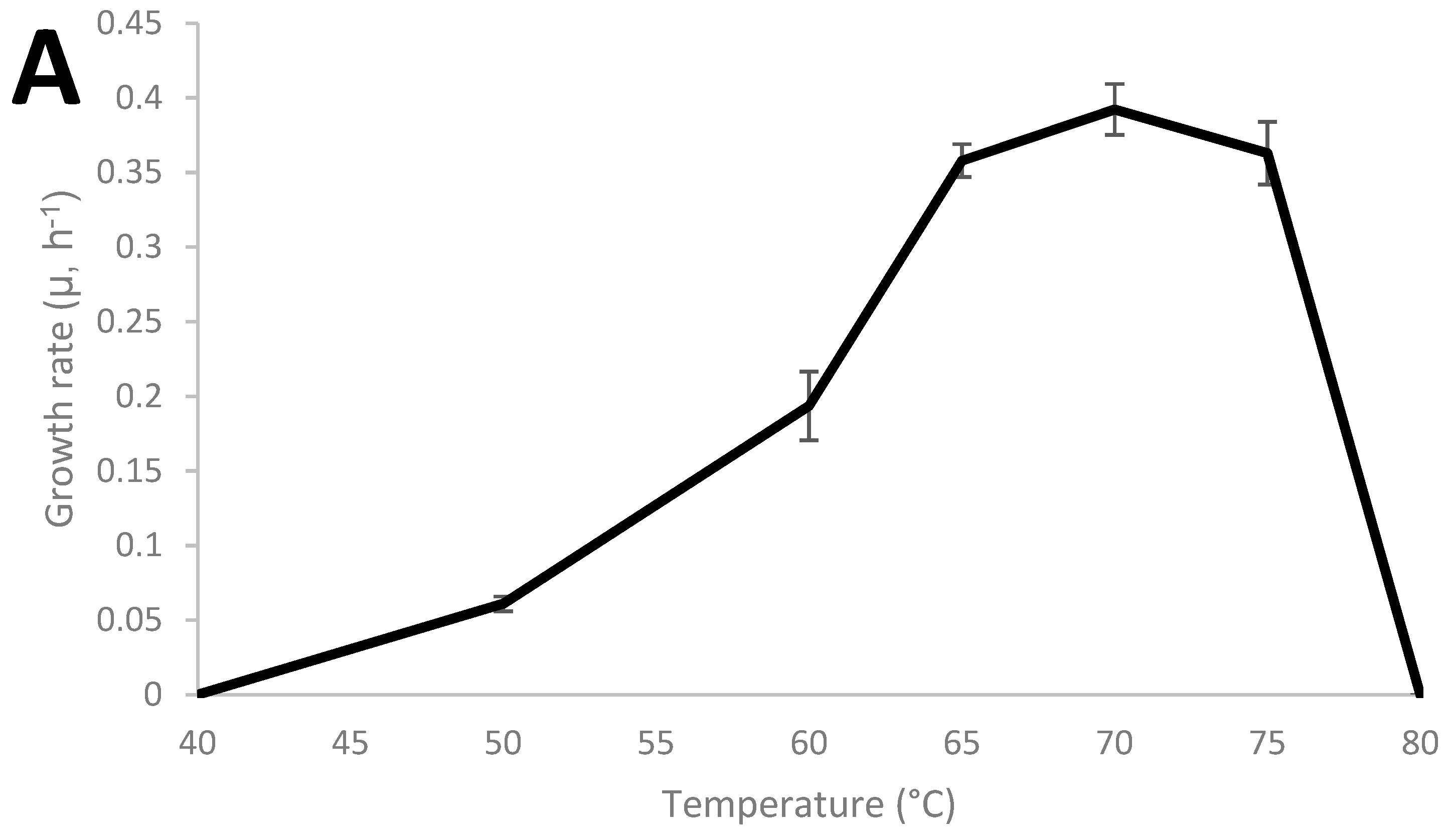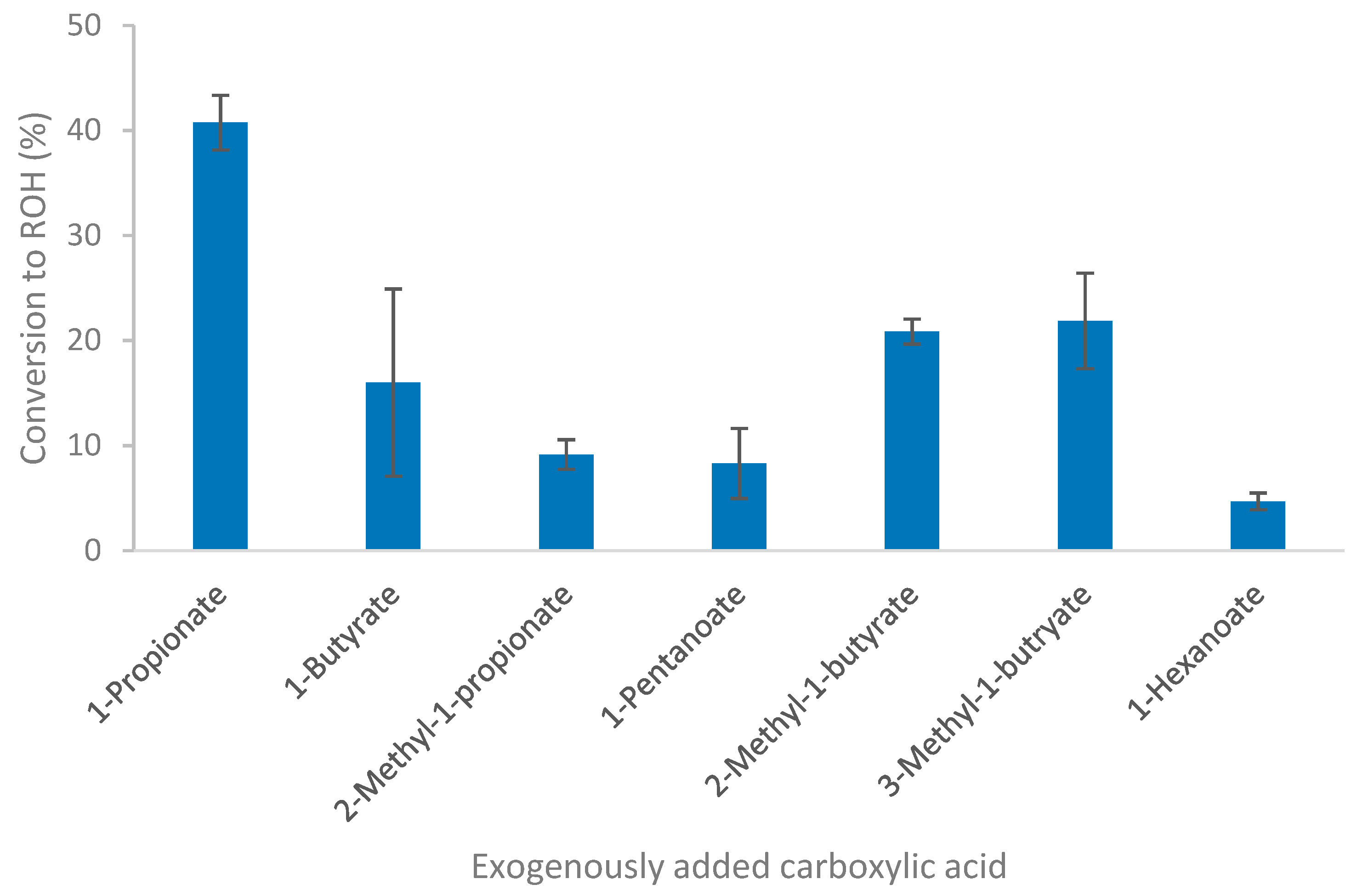Biotransformation of Carboxylic Acids to Alcohols: Characterization of Thermoanaerobacter Strain AK152 and 1-Propanol Production via Propionate Reduction
Abstract
1. Introduction
2. Materials and Methods
2.1. General Methods and Cultivation
2.2. Characterization and Substrate Spectra
2.3. Influence of Initial Glucose and Liquid-gas Phase Ratio
2.4. Reduction of Carboxylic Acids Using the Glucose as a Source of Reducing Potential
2.5. Influence of Initial Carboxylic Acid Concentration
2.6. Kinetic Study of Carboxylic Acid Reduction by Thermoanaerobacter Strain AK152
2.7. 13C NMR Experiments
2.8. Analytical Methods
3. Results
3.1. Strain Characterization
3.2. Influence of Culture Conditions
3.3. Carboxylic Acids Reduction by Thermoanaerobacter Strain AK152
3.4. Influence of Culture Conditions on Carboxylic acid Reduction
3.5. Kinetic Experiments
3.6. NMR with Thermoanaerobacter strain AK152
4. Discussion
5. Conclusions
Supplementary Materials
Author Contributions
Funding
Acknowledgments
Conflicts of Interest
References
- Taylor, M.P.; Eley, K.L.; Martin, S.; Tuffin, M.I.; Burton, S.G.; Cowan, D.A. Thermophilic Ethanologenesis: Future Prospects for Second-Generation Bioethanol Production. Trends Biotechnol. 2009, 27, 398–405. [Google Scholar] [CrossRef] [PubMed]
- Scully, S.M.; Orlygsson, J. Recent Advances in Second Generation Ethanol Production by Thermophilic Bacteria. Energies 2015, 8. [Google Scholar] [CrossRef]
- Glushchenko, E.V.; Kozlov, D.G.; Podkovyrov, S.M.; Mogutov, M. Isolation and Characteristics of Thermostable Pullulanase from Clostridium thermohydrosulfuricum Produced by Escherichia coli Cells. Mol. Biol. 1990, 24, 744–751. [Google Scholar]
- Kozlov, D.G.; Kurepina, N.E.; Glushchenko, E.V.; Mogutov, M.A.; Podkovyrov, S.M. Cloning and Expression of the Gene for Thermostable Pullulanase from Clostridium thermohydrosulfuricum in Escherichia Coli. Mol. Biol. 1990, 24, 736–743. [Google Scholar]
- Sonne-Hansen, J.; Mathrani, M.; Ahring, B.K. Xylanolytic Anaerobic Thermophiles from Icelandic Hot-Springs. Appl. Microbiol. Biotechnol. 1993, 38, 537–541. [Google Scholar] [CrossRef]
- Avci, A.; Donmez, S. A Novel Thermophilic Anaerobic Bacteria Producing Cyclodextrin Glycosyltransferase. Process Biochem. 2009, 44, 36–42. [Google Scholar] [CrossRef]
- Lee, Y.-E.; Jain, M.K.; Lee, C.; Zeikus, J.G. Taxonomic Distinction of Saccharolytic Thermophilic Anaerobes: Description of Thermoanaerobacterium xylanolyticum gen. nov., sp. ~ nov., and Thermoanaerobacterium saccharolyticum gen. nov., sp. nov.; Reclassification of Thermoanaerobium brockii, Clostridium thermosulfurogenes, and Clostridium thermohydrosulfiricum E100-69 as Thermoanaerobacter brockii comb. nov., Thermoanaerobacterium thermosulfurigenes comb. nov., and Thermoanaerobacter thermohydrosulfuricus comb. nov., Respectively; and Transfer of Clostridium thermohydrosulfuricum 39E to Thermoanaerobacter ethanolicus. Int. J. Syst. Bacteriol. 1993, 43, 41–51. [Google Scholar] [CrossRef]
- Antranikian, G.; Herzberg, C.; Gottschalk, G. Production of Thermostable Alpha-Amylase, Pullulanase, and Alpha-Glucosidase in Continuous Culture by a New Clostridium Isolate. Appl. Env. Microbiol. 1987, 53, 1668–1673. [Google Scholar] [CrossRef]
- Antranikian, G.; Gottschalk, G. Thermostable Amylases and Pullulanases from Two Anaerobic. U.S. Patent 4,929,557, 29 May 1990. [Google Scholar]
- Chades, T.; Scully, S.M.; Ingvadottir, E.M.; Orlygsson, J. Fermentation of Mannitol Extracts From Brown Macro Algae by Thermophilic Clostridia. Front. Microbiol. 2018, 9, 1–13. [Google Scholar] [CrossRef]
- Scully, S.M. Amino Acid and Related Catabolism of Thermoanaerobacter Species; University of Iceland: Reykjavik, Iceland, 2019. [Google Scholar]
- Jessen, J.E.J.; Orlygsson, J. Production of Ethanol from Sugars and Lignocellulosic Biomass by Thermoanaerobacter J1 Isolated from a Hot Spring in Iceland. J. Biomed. Biotechnol. 2012, 1869–1882. [Google Scholar] [CrossRef]
- Fraisse, L.; Simon, H. Observations on the Reduction of Non-Activated Carboxylates by Clostridium formicoaceticum with Carbon Monoxide or Formate and the Influence of Various Viologens. Arch. Microbiol. 1988, 150(4), 381–386. [Google Scholar] [CrossRef]
- Abrini, J.; Naveau, H.; Nyns, E. Clostridium autoethanogenum, sp. nov., an Anaerobic Bacterium That Produces Ethanol from Carbon Monoxide. Arch. Microbiol. 1994, 161, 345–351. [Google Scholar] [CrossRef]
- Fernández-Naveira, Á.; Veiga, M.C.; Kennes, C. Glucose Bioconversion Profile in the Syngas-Metabolizing Species Clostridium carboxidivorans. Bioresour. Technol. 2017, 244, 552–559. [Google Scholar] [CrossRef] [PubMed]
- Fernández-Naveira, Á.; Veiga, M.C.; Kennes, C. Effect of pH Control on the Anaerobic H-B-E Fermentation of Syngas in Bioreactors. J. Chem. Technol. Biotechnol. 2017, 92, 1178–1185. [Google Scholar] [CrossRef]
- Simon, H.; White, H.; Lebertz, H.; Thanos, I. Reduction of 2--Enoates and Alkanoates with Carbon Monoxide or Formate, Viologens, and Clostridium thermoaceticum to Saturated Acids and Unsaturated and Saturated Alcohols. Angew. Chem. Int. Ed. 1987, 26, 785–787. [Google Scholar] [CrossRef]
- Nissen, L.S.; Basen, M. The Emerging Role of Aldehyde:Ferredoxin Oxidoreductases in Microbially-Catalyzed Alcohol Production. J. Biotechnol. 2019, 306, 105–117. [Google Scholar] [CrossRef]
- Hitschler, L.; Kuntz, M.; Langschied, F.; Basen, M. Thermoanaerobacter Species Differ in Their Potential to Reduce Organic Acids to Their Corresponding Alcohols. Appl. Microbiol. Biotechnol. 2018, 102, 8465–8476. [Google Scholar] [CrossRef] [PubMed]
- Scully, S.M.; Brown, A.; Ross, A.B.; Orlygsson, J. Biotransformation of Organic Acids to Their Corresponding Alcohols by Thermoanaerobacter pseudoethanolicus. Anaerobe 2019, 57, 28–31. [Google Scholar] [CrossRef]
- Walther, T.; François, J.M. Microbial Production of Propanol. Biotechnol. Adv. 2016, 34, 984–996. [Google Scholar] [CrossRef]
- Tholazan, J.L.; Touzel, J.P.; Samain, E.; Grivet, J.P.; Prensier, G.; Albagnac, G. Clostridium neopropionicum sp. nov., a Strict Anaerobic Bacterium Fermenting Ethanol to Propionate through Acrylate Pathway. Arch. Microbiol. 1992, 157, 249–257. [Google Scholar] [CrossRef] [PubMed]
- Allen, S.H.G.; Kellermeyer, R.W.; Stjernholm, R.L.; Wood, H.G. Purification and Properties of Enzymes Involved in the Propionic Acid Fermentation. J. Bacteriol. 1964, 87, 171–187. [Google Scholar] [CrossRef] [PubMed]
- Wood, H.G. Metabolic Cycles in the Fermentation by Propionic Acid Bacteria. Curr. Top. Cell. Regul. 1981, 18, 255–287. [Google Scholar] [CrossRef] [PubMed]
- Atsumi, S.; Liao, J.C. Directed Evolution of Methanococcus jannaschii Citramalate Synthase for Biosynthesis of 1-Propanol and 1-Butanol by Escherichia Coli. Appl. Env. Microbiol. 2008, 74, 7802–7808. [Google Scholar] [CrossRef] [PubMed]
- Xu, H.; Zhang, Y.; Guo, X.; Ren, S.; Staempfli, A.A.; Chiao, J.; Jiang, W.; Zhao, G. Isoleucine Biosynthesis in Leptospira interrogans Serotype Lai Strain 56601 Proceeds via a Threonine-Independent Pathway. J. Bacteriol. 2004, 186, 5400–5409. [Google Scholar] [CrossRef] [PubMed]
- Srirangan, K.; Akawi, L.; Liu, X.; Westbrook, A.; Blondeel, E.J.M.; Aucoin, M.G.; Moo-young, M.; Chou, C.P. Manipulating the Sleeping Beauty Mutase Operon for the Production of 1-Propanol in Engineered Escherichia coli. Biotechnol. Biofuels 2013, 6, 1–14. [Google Scholar] [CrossRef]
- Jain, R.; Sun, X.; Yuan, Q.; Yan, Y. Systematically Engineering Escherichia coli for Enhanced Production of 1,2-Propanediol and 1-Propanol. Acs Synth. Biol. 2015, 4, 746–756. [Google Scholar] [CrossRef]
- Scully, S.M.; Iloranta, P.; Myllymaki, P.; Orlygsson, J. Branched-Chain Alcohol Formation by Thermophilic Bacteria within the Genera of Thermoanaerobacter and Caldanaerobacter. Extremophiles 2015, 19, 809–818. [Google Scholar] [CrossRef]
- Scully, S.M.; Orlygsson, J. Branched-Chain Amino Acid Catabolism of Thermoanaerobacter Strain AK85 and the Influence of Culture Conditions on Branched-Chain Alcohol Formation. Amino Acids 2019. [Google Scholar] [CrossRef]
- Orlygsson, J.; Baldursson, S.R.B. Phylogenetic and Physiological Studies of Four Hydrogen-Producing Thermoanareobes. Icel. Agric. Sci. 2007, 20, 93–105. [Google Scholar]
- Taylor, K.A.C.C. A Simple Colorimetric Assay for Muramic Acid and Lactic Acid. Appl. Biochem. Biotechnol. 1996, 56, 49–58. [Google Scholar] [CrossRef]
- Ingvadottir, E.M.; Scully, S.M.; Orlygsson, J. Evaluation of the Genus of Caldicellulosiruptor for Producation of 1,2-Propanediol from Methylpentoses. Anaerobe 2017, 47, 86–88. [Google Scholar] [CrossRef] [PubMed]
- Miller, G.L. Use of Dinitrosalicylic Acid Reagent for Determination of Reducing Sugar. Anal. Chem. 1959, 31, 426–428. [Google Scholar] [CrossRef]
- Isom, C.E.; Nanny, M.A.; Tanner, R.S. Improved Conversion Efficiencies for n-Fatty Acid Reduction to Primary Alcohols by the Solventogenic Acetogen “Clostridium ragsdalei. J. Ind. Microbiol. Biotechnol. 2015, 42, 29–38. [Google Scholar] [CrossRef] [PubMed]
- Perez, J.M.; Richter, H.; Loftus, S.E.; Angenent, L.T. Biocatalytic Reduction of Short-Chain Carboxylic Acids into Their Corresponding Alcohols with Syngas Fermentation. Biotechnol. Bioeng. 2013, 110, 1066–1077. [Google Scholar] [CrossRef]
- Vipotnik, Z.; Jessen, J.E.; Scully, S.M.; Orlygsson, J. Effect of Culture Conditions on Hydrogen Production by Thermoanaerobacter Strain AK68. Int. J. Hydrog. Energy 2016, 41. [Google Scholar] [CrossRef]
- Burdette, D.; Zeikus, J.G. Purification of Acetaldehyde Dehydrogenase and Alcohol Dehydrogenases from Thermoanaerobacter ethanolicus 39E and Characterization of the Secondary-Alcohol Dehydrogenase (2° Adh) as a Bifunctional Alcohol Dehydrogenase-Acetyl-CoA Reductive Thioes. Biochem. J. 1994, 302, 163–170. [Google Scholar] [CrossRef]
- Scully, S.M.; Örlygsson, J. Thermostable Thermoanaerobacter Alcohol Dehydrogenases and Their Use in Organic Synthesis. In Physiological and Biotechnological Aspects of Extremophiles; Salwan, R., Sharma, V., Eds.; Academic Press: Cambridge, MA, USA, 2020; pp. 183–193. [Google Scholar] [CrossRef]
- Musa, M.M.; Phillips, R.S. Recent Advances in Alcohol Dehydrogenase-Catalyzed Asymmetric Production of Hydrophobic Alcohols. Catal. Sci. Technol. 2011, 1, 1311–1323. [Google Scholar] [CrossRef]
- Bajapi, R.K.; Iannotti, E.L. Product Inhibition. In Handbook on Anaerobic Fermentations; Erickson, L.E., Fung, D.Y.-C., Eds.; Marcel Dekker, Inc.: New York, USA, 1988; pp. 207–241. [Google Scholar]
- Huffer, S.; Clark, M.E.; Ning, J.C.; Blanch, H.W.; Clark, D.S. Role of Alcohols in Growth, Lipid Composition, and Membrane Fluidity of Yeasts, Bacteria, and Archaea. Appl. Env. Microbiol. 2011, 77, 6400–6408. [Google Scholar] [CrossRef]
- Himmi, E.H.; Bories, A.; Boussaid, A.; Hassani, L. Propionic Acid Fermentation of Glycerol and Glucose by Propionibacterium acidipropionici and Propionibacterium freudenreichii ssp. Shermanii. Appl. Microbiol. Biotechnol. 2000, 53, 435–440. [Google Scholar] [CrossRef]
- Shen, C.R.; Liao, J.C. Metabolic Engineering of Escherichia coli for 1-Butanol and 1-Propanol Production via the Keto-Acid Pathways. Metab. Eng. 2008, 10, 312–320. [Google Scholar] [CrossRef] [PubMed]
- Shaw, A.J.; Miller, B.B.; Rogers, S.R.; Kenealy, W.R.; Meola, A.; Bhandiwad, A.; Sillers, W.R.; Shikhare, I.; Hogsett, D.A.; Herring, C.D. Anaerobic Detoxification of Acetic Acid in a Thermophilic Ethanologen. Biotechnol. Biofuels 2015, 8, 1–12. [Google Scholar] [CrossRef] [PubMed]









| Organism | Pathway | Substrate | 1-PrOH Titer | Conversion (%) | Reference |
|---|---|---|---|---|---|
| Thermoanaerobacter strain AK152 | RCOOH red | Glu (20 mM) +propionate (20 mM), pH 6.5 | 691 mg/L (11.5 mM) | 57.3% | This study |
| Thermoanaerobacter strain X514 | RCOOH red, cell suspension | Glu (25 mM) + propionate (50 mM) | 1.5 g/L (25 mM) | 50% | [19] |
| T. pseudoethanolicus | RCOOH red | Glu (20 mM) +propionate (20 mM) | 397 mg/L (11.5 mM) | 33% | [20] |
| T. brockii subsp. finnii | RCOOH red, cell suspension | Glu (25 mM) + propionate (50 mM) | 1.3 g/mL (21 mM) | 42% | [19] |
| C. ljungdahlii ERI-2 | RCOOH red | CO + propionate (15 mM) | 627 mg/mL (10.4 mM) | 69.4% | [36] |
| “C. ragsdalei” | RCOOH red | CO + propionate (15 mM) | 451 mg/L (7.5 mM) | 30% | [36] |
| “C. ragsdalei” | RCOOH red | CO + propionate (30 mM) | 1.74 g/L (29 mM) | 97% | [35] |
| P. acidipropionicum | W-W | Glycerol (20 g/L) | <2.0 g/L | N/A | [43] |
| P. acidipropionicum | W-W | Glu (20 g/L) | <1.0 g/L | N/A | [43] |
| P. freudenreichii | W-W | Glycerol (20 g/L) | <2.0 g/L | N/A | [43] |
| P. freudenreichii | W-W | Glu (20 g/L) | <1.0 g/L | N/A | [43] |
| E. coli | GE (Suc) | Glu (20 g/L) + succinate (4 g/L) | 168 mg (2.8 mM) | N/A | [27] |
| E. coli | GE (Cit) | Glu | 3.5 g/L (58.2 mM) | N/A | [25] |
| E. coli | GE (Thr) | Tryptone (10 g/L) | 1.0 g/L (16.6 mM) | N/A | [44] |
| E. coli | GE (1,2-PD) | Glu | 1.0 g/L (16.6 mM) | N/A | [28] |
© 2020 by the authors. Licensee MDPI, Basel, Switzerland. This article is an open access article distributed under the terms and conditions of the Creative Commons Attribution (CC BY) license (http://creativecommons.org/licenses/by/4.0/).
Share and Cite
Scully, S.M.; Orlygsson, J. Biotransformation of Carboxylic Acids to Alcohols: Characterization of Thermoanaerobacter Strain AK152 and 1-Propanol Production via Propionate Reduction. Microorganisms 2020, 8, 945. https://doi.org/10.3390/microorganisms8060945
Scully SM, Orlygsson J. Biotransformation of Carboxylic Acids to Alcohols: Characterization of Thermoanaerobacter Strain AK152 and 1-Propanol Production via Propionate Reduction. Microorganisms. 2020; 8(6):945. https://doi.org/10.3390/microorganisms8060945
Chicago/Turabian StyleScully, Sean Michael, and Johann Orlygsson. 2020. "Biotransformation of Carboxylic Acids to Alcohols: Characterization of Thermoanaerobacter Strain AK152 and 1-Propanol Production via Propionate Reduction" Microorganisms 8, no. 6: 945. https://doi.org/10.3390/microorganisms8060945
APA StyleScully, S. M., & Orlygsson, J. (2020). Biotransformation of Carboxylic Acids to Alcohols: Characterization of Thermoanaerobacter Strain AK152 and 1-Propanol Production via Propionate Reduction. Microorganisms, 8(6), 945. https://doi.org/10.3390/microorganisms8060945






